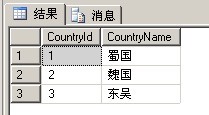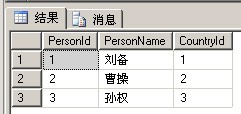NHibernate 集合映射基础(第四篇) - 一对一、 一对多、多对多小示例
映射文件,用于告诉NHibernate数据库里的表、列于.Net程序中的类的关系。因此映射文件的配置非常重要。
一、一对一
NHibernate一对一关系的配置方式使用<one-to-one>配置节点。
当我们两个表拥有相同的主键字段,主键值相同的需要关联在一起。比较典型的一个例子是,一个对象的属性太多,常用的和不常用的分开存放。例如一个文章表,我们将文章内容字段,提取出来作为一个单独的字段,因为比较长。
下面我们来新建两张表如下:

本来, Article表还有很多字段,比如添加时间,所属栏目,是否高亮,是否置顶等等,但是本处仅仅做示范NHibernate一对多一配置之使用。因此简略了。
Article.hbm.xml
<?xml version="1.0" encoding="utf-8" ?>
<hibernate-mapping xmlns="urn:nhibernate-mapping-2.2">
<class name="Model.ArticleModel,Model" table="Article">
<id name="Id" column="ArticleId" type="Int32">
<generator class="native"/>
</id>
<one-to-one name="Content" cascade="all" />
<property name="Title" column="ArticleTitle" type="String"/>
</class>
</hibernate-mapping>
Content.hbm.xml
<?xml version="1.0" encoding="utf-8" ?>
<hibernate-mapping xmlns="urn:nhibernate-mapping-2.2">
<class name="Model.ContentModel,Model" table="Content">
<id name="Id" column="ArticleId" type="Int32">
<generator class="native"/>
</id>
<one-to-one name="Article" cascade="all" />
<property name="Content" column="ArticleContent" type="String"/>
</class>
</hibernate-mapping>
ArticleModel.cs
public class ArticleModel
{
public virtual int Id { get; set; }
public virtual string Title { get; set; }
public virtual ContentModel Content { get; set; }
}
ContentModel.cs
public class ContentModel
{
public virtual int Id { get; set; }
public virtual string Content { get; set; }
public virtual ArticleModel Article { get; set; }
}
Program.cs
class Program
{
static void Main(string[] args)
{
ISessionFactory sessionFactory = new Configuration().Configure().BuildSessionFactory(); using (ISession session = sessionFactory.OpenSession())
{
ArticleModel art = session.Get<ArticleModel>();
Console.WriteLine(art.Id);
Console.WriteLine(art.Title);
Console.WriteLine(art.Content.Content);
} Console.ReadKey();
}
}
输出结果如下:

2016-05-16:今天对一对一又有新理解。
像上面这种主键关联一对一,可以设置两种方式。
<one-to-one name="ArtContent" cascade="none" constrained="true"/> 对象1配置方式
<one-to-one name="Article" cascade="all" constrained="true" /> 对象2配置方式
这样设置有什么好处呢?
1、cascade="none"那个,是不关联。不需要关联的操作,选择上面这个对象来Add,Select,Update。SELECT是个严重的问题,数据多了以后,如果不需要Join的情况下Join了,资源浪费,很慢。
2、cascade="all",需要关联的操作,使用下面这个对象来操作。
之前弄错了,配置成这样。
<one-to-one name="ArtContent" /> 对象1配置方式
<one-to-one name="Article" cascade="all" constrained="true" /> 对象2配置方式
因为,如果你什么关联都不写,有可能会是级联操作,即使你不希望关联,NHibernate也会关联,查询的时候默认关联查询出了你不需要的对象。所以会造成资源浪费的问题。
当然,整个NHibernate外层还可以配置默认的default-cascade关联操作。
有时间还是要多跟跟SQL语句,才能明白怎样配置才是最优的。
二、一对多
来看以下两张表,这是一个典型的一对多关系。人与国家:
Country表:

Person表:

NHibernate映射文件配置基础,一对多配置示例。先来看看映射文件:
Country.hbm.xml
<?xml version="1.0" encoding="utf-8" ?>
<hibernate-mapping xmlns="urn:nhibernate-mapping-2.2">
<class name="Model.CountryModel, Model" table="Country">
<id name="CountryId" column="CountryId" type="Int32">
<generator class="native"/>
</id>
<property name="CountryName" column="CountryName" type="String"/>
<!-- 一个Country里面有多个Person -->
<set name="ListPerson" table="Person" generic="true" inverse="true">
<key column="CountryId" foreign-key="FK_Person_Country"/>
<one-to-many class="Model.PersonModel,Model"/>
</set>
</class>
</hibernate-mapping>
Person.hbm.xml
<?xml version="1.0" encoding="utf-8" ?>
<hibernate-mapping xmlns="urn:nhibernate-mapping-2.2">
<class name="Model.PersonModel, Model" table="Person">
<id name="PersonId" column="PersonId" type="Int32">
<generator class="native"/>
</id>
<property name="PersonName" column="PersonName" type="String"/>
<!--多对一关系:Person属于一个Country name是Person实体类里的-->
<many-to-one name="Country" column="CountryId" not-null="true" class="Model.CountryModel,Model" foreign-key="FK_Person_Country" />
</class>
</hibernate-mapping>
CountryModel.cs
namespace Model
{
public class CountryModel
{
public virtual int CountryId { get; set; }
public virtual string CountryName { get; set; }
//N个PersonModel属于一个CountryModel
public virtual ISet<PersonModel> ListPerson { get; set; }
}
}
PersonModel.cs
namespace Model
{
public class PersonModel
{
public virtual int PersonId { get; set; }
public virtual string PersonName { get; set; }
//要注意到一个PersonModel是属于一个CountryModel
public virtual CountryModel Country { get; set; }
}
}
这里要说明以下,NHibernate巧妙地通过集合与实体解决了一对多、多对一关系。将延迟加载发挥到极限。
CountryDao.cs:
namespace Dao
{
public class CountryDao
{public IList<CountryModel> GetCountyList()
{
ISession NSession = NHibernateHelper.GetSession();
return NSession.QueryOver<CountryModel>().List();
}
}
}
PersonDao.cs:
namespace Dao
{
public class PersonDao
{public IList<PersonModel> GetPersonList()
{
ISession NSession = NHibernateHelper.GetSession();
return NSession.QueryOver<PersonModel>().List();
}
}
}
Program.cs:
class Program
{
static void Main(string[] args)
{
PersonDao pDao = new PersonDao();
IList<PersonModel> ListPerson = pDao.GetPersonList();
foreach (PersonModel p in ListPerson)
{
//输出Person所属的国家名
Console.WriteLine(p.PersonId + " " + p.PersonName + " " + p.Country.CountryName);
} CountryDao cDao = new CountryDao();
IList<CountryModel> ListCountry = cDao.GetCountyList();
foreach (CountryModel m in ListCountry)
{
Console.WriteLine(m.CountryName + ":");
//循环输出该国家的所有人名
foreach (PersonModel p1 in m.ListPerson)
{
Console.WriteLine("--" + p1.PersonName);
}
} Console.ReadKey();
}
}
输出结果如下:

虽然你没有写过一句join,但是你直接就能够"."出来了相关的东西,感觉NHibernate非常强大。不过方便归方便,SQL语句可不能忘。
延迟加载小尝甜头
下面来玩点有趣的东西,在Dao里加如下一个方法:
public PersonModel GetPerson()
{
ISession NSession = NHibernateHelper.GetSession();
return NSession.Get<PersonModel>();
}
Program.cs主程序改为如下:
static void Main(string[] args)
{
PersonDao dao = new PersonDao();
PersonModel p = dao.GetPerson();
Console.WriteLine(p.PersonId);
Console.WriteLine(p.PersonName);
Thread.Sleep();
//停止5秒钟后,再输出个人所属国家名
Console.WriteLine(p.Country.CountryName);
}
对于输出结果我不关注,我关注的是NHibernate对SQLServer做了什么,我们来看看SQL Server Profiler监控到了什么?

留意两条SQL语句的执行时间间隔,刚好是5秒,那么sql语句是什么呢?
exec sp_executesql N'SELECT personmode0_.PersonId as PersonId0_0_, personmode0_.PersonName as PersonName0_0_, personmode0_.CountryId as CountryId0_0_ FROM Person personmode0_ WHERE
personmode0_.PersonId=@p0',N'@p0 int',@p0=1
--第一条:等价于 SELECT PersonId,PersonName,CountryId FROM Person WHERE PersonId = 1
exec sp_executesql N'SELECT countrymod0_.CountryId as CountryId1_0_, countrymod0_.CountryName as CountryN2_1_0_ FROM Country countrymod0_ WHERE countrymod0_.CountryId=@p0',N'@p0
int',@p0=1
--第二条:等价于 SELECT CountryId,CountryName FROM WHEE CountryId = 1
留意到NHibernate并没有采用inner join的语法,将Country的数据也一并从数据库读到程序中,而是当C#5秒后要用到CountryName这个东西的时候,它才去数据库读取。很明显的结论,如果C#不打算输出CountryName,NHibernate根本不会执行第二条SQL语句。
延迟加载 lazy:true
下面再来一点点变种,在Country.hbm.xml映射文件里的第一行加上一句 lazy="false"如下:
<class lazy="false" name="Model.CountryModel, Model" table="Country">
在执行显示结果上面,完全没变化,但是用SQL Server Profiler看的到SQL语句如下:
exec sp_executesql N'SELECT personmode0_.PersonId as PersonId0_1_, personmode0_.PersonName as PersonName0_1_, personmode0_.CountryId as CountryId0_1_, countrymod1_.CountryId as
CountryId1_0_, countrymod1_.CountryName as CountryN2_1_0_ FROM Person personmode0_ inner join Country countrymod1_ on personmode0_.CountryId=countrymod1_.CountryId WHERE
personmode0_.PersonId=@p0',N'@p0 int',@p0=1
--SQL语句等价于:
SELECT p.PersonId,p.PersonName,p.CountryId,c.CountryId,c.CountryName FROM Person AS p
INNER JOIN Country AS c
ON P.CountryId = c.CountryId
可以看到,如果禁止Country表使用延迟加载,那么NHibernate就会被逼得使用Inner Join一次把所有的数据都读出来,无论你用没用到另外一张表中的数据。
不可变类,mutable="false"
还是利用这个例子,来看看不可变类是什么意思,我们将Person.hbm.xml的第一行加上一个mutable="false",变为:
<class name="Model.PersonModel, Model" table="Person" mutable="false">
PersonDao.cs写一个Delete方法如下:
public void Delete()
{
ISession NSession = NHibernateHelper.GetSession();
PersonModel p = NSession.Get<PersonModel>();
Session.Delete(p);
}
然后在Program.cs中调用它。
PersonDao dao = new PersonDao();
dao.Delete();
你希望看到什么?答案是:SQL Server Profiler显示没有任何SQL语句被执行。而再次查询也同样还有PersonId为1的Person数据在。
对于NHibernate的映射配置属性,非常多,不可能一一示例。如果需要查询比较详细的映射配置信息,可以到这里http://www.cnblogs.com/kissdodog/archive/2013/02/21/2919886.html。
三、多对多
还是以一个最简单的示例来说明,一个程序员可以开发多个软件,一个软件可以由多个程序员共同开发。典型的数据表如下:

先来看Person.hbm.xml的映射文件配置如下:
<?xml version="1.0" encoding="utf-8" ?>
<hibernate-mapping xmlns="urn:nhibernate-mapping-2.2">
<class name="Model.PersonModel, Model" table="Person">
<id name="PersonId" column="PersonId" type="Int32">
<generator class="native"/>
</id>
<property name="PersonName" column="PersonName" type="String"/>
<!-- 多对多关系 对应多个软件 -->
<bag name="Softs" generic="true" table="PersonSoft">
<key column="PersonId" foreign-key="FK_PersonSoft_Person"/>
<many-to-many column="SoftId" class ="Model.SoftModel,Model" foreign-key="FK_PersonSoft_Soft"/>
</bag>
</class>
</hibernate-mapping>
Soft.hbm.xml如下:
<?xml version="1.0" encoding="utf-8" ?>
<hibernate-mapping xmlns="urn:nhibernate-mapping-2.2">
<class name="Model.SoftModel, Model" table="Soft">
<id name="SoftId" column="SoftId" type="Int32">
<generator class="native"/>
</id>
<property name="SoftName" column="SoftName" type="String"/>
<!-- 多对多关系 对应多个程序员 name属性名,table中间表名 -->
<bag name="Persons" generic="true" table="PersonSoft">
<key column="SoftId" foreign-key="FK_PersonSoft_Soft"/> <!--主键列,主键表的外键名称-->
<many-to-many column="PersonId" class ="Model.PersonModel,Model" foreign-key="FK_PersonSoft_Person"/> <!--外键列,外键类,外键名称-->
</bag>
</class>
</hibernate-mapping>
SoftModel.cs:
public class SoftModel
{
public virtual int SoftId { get; set; }
public virtual string SoftName { get; set; }
//多对多关系:一个软件由多个程序员开发
public virtual IList<PersonModel> Persons { get; set; }
}
PersonModel.cs:
public class PersonModel
{
public virtual int PersonId{ get; set; }
public virtual string PersonName{ get; set; }
//多对多关系:一个程序员可以开发多个软件
public virtual IList<SoftModel> Softs { get; set; }
}
现在我们来看一个基本的需求,我们现在知道一个人的Id,要求出这个人所开发的软件
public class PersonDao
{
public PersonModel GetPerson(int Id)
{
ISession NSession = NHibernateHelper.GetSession();
return NSession.Get<PersonModel>(Id);
}
}
上面代码实现的是根据Id,查询到人的实体对象。
Program.cs:
static void Main(string[] args)
{
PersonDao dao = new PersonDao();
PersonModel p = dao.GetPerson();
Console.WriteLine(p.PersonName + "开发的软件有:");
foreach (SoftModel soft in p.Softs) //什么都没有干,纯粹是.出来的
{
Console.WriteLine("--" + soft.SoftName);
}
}
但是到调用的时候,只要我们得到了PersonModel的对象,就能够直接点出它所开发出的软件列表。
以上代码显示结果如下:

你现在领略到NHibernate的恐怖之处的吧,也知道为什么配置那么复杂了吧,配置复杂了,写SQL语句的时间都省了。
第一步根据Id查出PersonModel实体类的对象,这个就忽略了。关键是第二步,当我们点(.)出Softs的时候,NHibernate做了什么呢?
exec sp_executesql N'SELECT softs0_.PersonId as PersonId1_, softs0_.SoftId as SoftId1_, softmodel1_.SoftId as SoftId3_0_, softmodel1_.SoftName as SoftName3_0_ FROM PersonSoft softs0_
left outer join Soft softmodel1_ on softs0_.SoftId=softmodel1_.SoftId WHERE softs0_.PersonId=@p0',N'@p0 int',@p0=1
--相当于下面的SQL语句
SELECT ps.PersonId,ps.SoftId,s.SoftId,S.SoftName FROM PersonSoft ps
LEFT OUTER JOIN Soft s ON ps.SoftId = s.SoftId
WHERE ps.PersonId = 1
NHibernate在我们点的时候,生成了SQL语句,并返回了结果。
以前要写一大坨SQL语句,现在只需要一个点(.),不过千万要记住,SQL语句不能忘。
NHibernate 集合映射基础(第四篇) - 一对一、 一对多、多对多小示例的更多相关文章
- NHibernate 集合映射深入 (第五篇) <set>,<list>,<map>,<bag>
一.集合外键 在NHibernate中,典型的用于映射集合类的元素有<set>,<list>,<map>,<bag>,<array>,< ...
- NHibernate 映射基础(第三篇) 简单映射、联合主键
NHibernate 映射基础(第三篇) 简单映射.联合主键 NHibernate完全靠配置文件获取其所需的一切信息,其中映射文件,是其获取数据库与C#程序关系的所有信息来源. 一.简单映射 下面先来 ...
- JPA级联(一对一 一对多 多对多)注解【实际项目中摘取的】并非自己实际应用
下面把项目中的用户类中有个:一对一 一对多 多对多的注解对应关系列取出来用于学习 说明:项目运行正常 问题类:一对多.一对一.多对多 ============一对多 一方的设置 @One ...
- Python进阶----表与表之间的关系(一对一,一对多,多对多),增删改查操作
Python进阶----表与表之间的关系(一对一,一对多,多对多),增删改查操作,单表查询,多表查询 一丶表与表之间的关系 背景: 由于如果只使用一张表存储所有的数据,就会操作数 ...
- mybatis 一对一 一对多 多对多
一对一 一对多 多对多
- NHibernate3剖析:Mapping篇之集合映射基础(3):List映射
系列引入 NHibernate3.0剖析系列分别从Configuration篇.Mapping篇.Query篇.Session策略篇.应用篇等方面全面揭示NHibernate3.0新特性和应用及其各种 ...
- NHibernate3剖析:Mapping篇之集合映射基础(2):Bag映射
系列引入 NHibernate3.0剖析系列分别从Configuration篇.Mapping篇.Query篇.Session策略篇.应用篇等方面全面揭示NHibernate3.0新特性和应用及其各种 ...
- NHibernate 继承映射(第十六篇)
在NHibernate的映射中,关于继承的映射策略有3种方式 单表继承 类表继承 具体表继承 另外还有一种比较特别的多态映射 隐式多态 下面分别来阐述NHibernate继承映射的各种策略要点. 一. ...
- 使用NHibernate(7)-- 一对一 && 一对多 && 多对多
1, 一对一. 对于数据量比较大的时候,考虑查询的性能,肯能会把一个对象的属性分到两个表中存放:比如用户和用户资料,经常使用的一般是Id和用户名,用户资料(学校,籍贯等)是不经常被查询的,所以就会分成 ...
随机推荐
- hardseed
hardseed https://github.com/yangyangwithgnu/hardseed
- gcc -rpath 指定动态库路径
gcc -rpath 指定动态库路径 http://blog.csdn.net/v6543210/article/details/44809405
- Timer类
构造方法:public Timer() 创建一个新计时器.相关的线程不 作为守护程序运行. public Timer(boolean isDaemon) 创建一个新计时器,可以指定其相关的线程作为守护 ...
- 2017多校第9场 HDU 6166 Senior Pan 堆优化Dij
题目链接:http://acm.hdu.edu.cn/showproblem.php?pid=6166 题意:给你一个有向图,然后给你k个点,求其中一个点到另一个点的距离的最小值. 解法:枚举二进制位 ...
- Centos7 安装
一.先把Centos7的镜像下载到本地 镜像下载网址:http://archive.kernel.org/centos-vault/ (里面有任何需要的版本) 二.启动VMware 1. 创建新的虚拟 ...
- 23:django 信号(signal)
django包含了一个“信号分配器”使得当一些动作在框架的其他地方发生的时候,解耦的应用可以得到提醒.通俗来讲,就是一些动作发生的时候,信号允许特定的发送者去提醒一些接受者,这是特别有用的设计因为有些 ...
- linux命令(4):vmstat命令
CPU监控如下: vmstat 2 10 //表示每隔2秒运行10次 内存监控如下: vmstat –s 监控进程及CPU.内存状态 如下: top
- Linux安全之密钥登录
我们一般使用 PuTTY 等 SSH 客户端来远程管理 Linux 服务器.但是,一般的密码方式登录,容易有密码被暴力破解的问题.所以,一般我们会将 SSH 的端口设置为默认的 22 以外的端口,或者 ...
- zoj 4020 The 18th Zhejiang University Programming Contest Sponsored by TuSimple - G Traffic Light(广搜)
题目链接:The 18th Zhejiang University Programming Contest Sponsored by TuSimple - G Traffic Light 题解: 题意 ...
- python中,将字符串由utf8转gbk
uni_str = utf8_str.decode('utf-8'); gbk_str = uni_str.encode('gbk');
